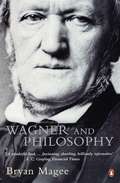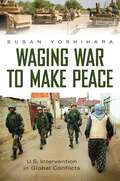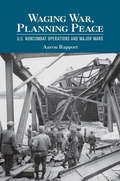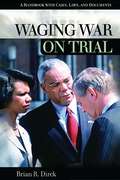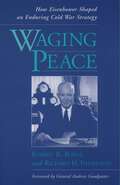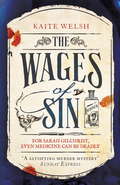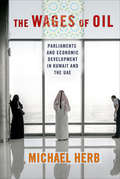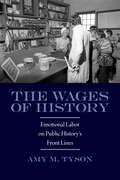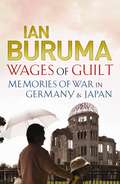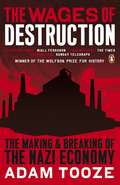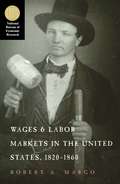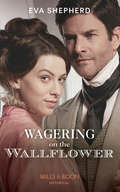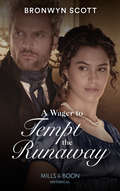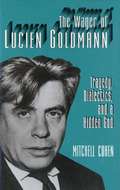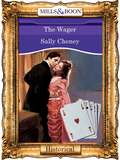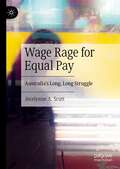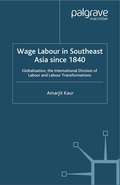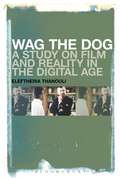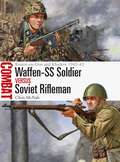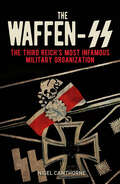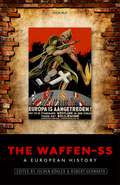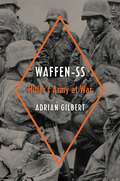- Table View
- List View
Wagner and Philosophy: Wagner And Philosophy
by Bryan MageeWagner was one of the few major composers who studied philosophy seriously. Bryan Magee places the composer's artistic development in the context of the philosophy of his age, and gives us the first detailed and comprehensive study of the close links between Wagner and the philosophers - from the pre-Marxist socialists to Feuerbach and Schopenhauer. Magee explores the relationship between words and music, between the conscious and the unconscious mind, between art and philosophy. It tackles soberly and judiciously the Wagner whose paranoia, egocentricity and anti-semitism are repugnant, as well as the Wagner of artistic genius. The resulting text illuminates Wagner and the music-dramas in altogether new ways.
Waging War to Make Peace: U.S. Intervention in Global Conflicts (Praeger Security International)
by Susan YoshiharaA revealing examination looks at the decision-making in four NATO capitals about waging war in Kosovo and Iraq.Written by a combat veteran who also served on the faculty of the Naval War College, Waging War to Make Peace: U.S. Intervention in Global Conflicts is a thought-provoking analysis of the decision to make war in the modern world. The subject is examined through the lens of the decision-making of four NATO nations—Britain, France, Germany, and the United States—in the 1999 Kosovo campaign compared to their decisions in 2003 regarding the Iraq war.What emerges is a picture of how the bitter dispute over Iraq was the result of disagreements about who has the authority to wage war, when it is justified, and whether nations have an obligation to intervene in the case of human rights and humanitarian emergencies. The book shows how those who enthusiastically hailed a new era of warfare based upon human rights and humanitarian values misjudged the significance of the Kosovo decision, and it underscores issues with which leaders must come to grips if NATO allies are to avoid broader disputes in the years ahead.
Waging War, Planning Peace: U.S. Noncombat Operations and Major Wars (Cornell Studies in Security Affairs)
by Aaron RapportAs the U.S. experience in Iraq following the 2003 invasion made abundantly clear, failure to properly plan for risks associated with postconflict stabilization and reconstruction can have a devastating impact on the overall success of a military mission. In Waging War, Planning Peace, Aaron Rapport investigates how U.S. presidents and their senior advisers have managed vital noncombat activities while the nation is in the midst of fighting or preparing to fight major wars. He argues that research from psychology—specifically, construal level theory—can help explain how individuals reason about the costs of postconflict noncombat operations that they perceive as lying in the distant future. In addition to preparations for "Phase IV" in the lead-up to the Iraq War, Rapport looks at the occupation of Germany after World War II, the planned occupation of North Korea in 1950, and noncombat operations in Vietnam in 1964 and 1965. Applying his insights to these cases, he finds that civilian and military planners tend to think about near-term tasks in concrete terms, seriously assessing the feasibility of the means they plan to employ to secure valued ends. For tasks they perceive as further removed in time, they tend to focus more on the desirability of the overarching goals they are pursuing rather than the potential costs, risks, and challenges associated with the means necessary to achieve these goals. Construal level theory, Rapport contends, provides a coherent explanation of how a strategic disconnect can occur. It can also show postwar planners how to avoid such perilous missteps.
Waging War on Trial: A Handbook with Cases, Laws, and Documents (On Trial)
by Brian R. DirckA thought-provoking and engaging guide to the legal, moral, and political issues that arise when the United States goes to war.From the American Revolution to the Bush administration's new type of war on terror, Waging War on Trial views warfare from a legal, social, cultural, and political standpoint. Included are homefront debates during major hostilities, "brushfire" incidents, and how the events of September 11th have shaped our domestic wartime policy.The battle continues today as the President and Congress debate over who begins and ends military operations. Concerns about civil liberties, the draft, and internal security are as relevant today as during the Civil War. Questions arise on how dissenters and minorities are treated and if America can legally control the behavior of our soldiers. It's an intricate interplay between war and America's institutions.
Waging Peace: How Eisenhower Shaped an Enduring Cold War Strategy
by Robert R. Bowie Richard H. ImmermanWaging Peace offers the first fully comprehensive study of Eisenhower's "New Look" program of national security, which provided the groundwork for the next three decades of America's Cold War strategy. Though the Cold War itself and the idea of containment originated under Truman, it was left to Eisenhower to develop the first coherent and sustainable strategy for addressing the issues unique to the nuclear age. To this end, he designated a decision-making system centered around the National Security Council to take full advantage of the expertise and data from various departments and agencies and of the judgment of his principal advisors. The result was the formation of a "long haul" strategy of preventing war and Soviet expansion and of mitigating Soviet hostility. Only now, in the aftermath of the Cold War, can Eisenhower's achievement be fully appreciated. This book will be of much interest to scholars and students of the Eisenhower era, diplomatic history, the Cold War, and contemporary foreign policy.
Waging Peace: How Eisenhower Shaped an Enduring Cold War Strategy
by Richard H. Immerman Robert R. BowieWaging Peace offers the first fully comprehensive study of Eisenhower's "New Look" program of national security, which provided the groundwork for the next three decades of America's Cold War strategy. Though the Cold War itself and the idea of containment originated under Truman, it was left to Eisenhower to develop the first coherent and sustainable strategy for addressing the issues unique to the nuclear age. To this end, he designated a decision-making system centered around the National Security Council to take full advantage of the expertise and data from various departments and agencies and of the judgment of his principal advisors. The result was the formation of a "long haul" strategy of preventing war and Soviet expansion and of mitigating Soviet hostility. Only now, in the aftermath of the Cold War, can Eisenhower's achievement be fully appreciated. This book will be of much interest to scholars and students of the Eisenhower era, diplomatic history, the Cold War, and contemporary foreign policy.
The Wages of Sin: A compelling tale of medicine and murder in Victorian Edinburgh (Sarah Gilchrist Mysteries Ser. #1)
by Kaite WelshAn irresistible mystery set in 1890s Edinburgh, Kaite Welsh's THE WAGES OF SIN features a female medical student-turned-detective, and will thrill fans of Sarah Waters and Antonia Hodgson.'Historical fiction doesn't get much more delicious or original' Damian Barr'This powerful novel combines a disturbing look at late Victorian attitudes towards women and morality with a satisfying murder mystery' Sunday ExpressSarah Gilchrist has fled from London to Edinburgh in disgrace and is determined to become a doctor, despite the misgivings of her family and society. As part of the University of Edinburgh's first intake of female medical students, Sarah comes up against resistance from lecturers, her male contemporaries, and - perhaps worst of all - her fellow women, who will do anything to avoid being associated with a fallen woman...When one of Sarah's patients turns up in the university dissecting room as a battered corpse, Sarah finds herself drawn into Edinburgh's dangerous underworld of bribery, brothels and body snatchers - and a confrontation with her own past.What readers are saying about THE WAGES OF SIN:'Sarah Gilchrist is a brilliant lead character. Atmospheric and evocative. Well worth a read' 'A fascinating exploration of how women were treated in Victorian times, enveloped in a dark murder mystery. It kept me guessing and kept me wanting more. One of my favourite historical fictions ever' 'A punchy, feminist page-turner with a wonderful sense of atmosphere'
The Wages of Oil: Parliaments and Economic Development in Kuwait and the UAE
by Michael HerbThe contrast between Kuwait and the UAE today illustrates the vastly different possible futures facing the smaller states of the Gulf. Dubai's rulers dream of creating a truly global business center, a megalopolis of many millions attracting immigrants in great waves from near and far. Kuwait, meanwhile, has the most spirited and influential parliament in any of the oil-rich Gulf monarchies.In The Wages of Oil, Michael Herb provides a robust framework for thinking about the future of the Gulf monarchies. The Gulf has seen enormous changes in recent years, and more are to come. Herb explains the nature of the changes we are likely to see in the future. He starts by asking why Kuwait is far ahead of all other Gulf monarchies in terms of political liberalization, but behind all of them in its efforts to diversify its economy away from oil. He compares Kuwait with the United Arab Emirates, which lacks Kuwait’s parliament but has moved ambitiously to diversify. This data-rich book reflects the importance of both politics and economic development issues for decision-makers in the Gulf. Herb develops a political economy of the Gulf that ties together a variety of issues usually treated separately: Kuwait's National Assembly, Dubai's real estate boom, the paucity of citizen labor in the private sector, class divisions among citizens, the caste divide between citizens and noncitizens, and the politics of land.
The Wages of History: Emotional Labor on Public History's Front Lines (Public History in Historical Perspective)
by Amy Tyson Amy M. TysonAnyone who has encountered costumed workers at a living history museum may well have wondered what their jobs are like, churning butter or firing muskets while dressed in period clothing. In The Wages of History, Amy Tyson enters the world of the public history interpreters at Minnesota's Historic Fort Snelling to investigate how they understand their roles and experience their daily work. Drawing on archival research, personal interviews, and participant observation, she reframes the current discourse on history museums by analyzing interpreters as laborers within the larger service and knowledge economies. Although many who are drawn to such work initially see it as a privilege—an opportunity to connect with the public in meaningful ways through the medium of history—the realities of the job almost inevitably alter that view. Not only do interpreters make considerable sacrifices, both emotional and financial, in order to pursue their work, but their sense of special status can lead them to avoid confronting troubling conditions on the job, at times fueling tensions in the workplace. This case study also offers insights—many drawn from the author's seven years of working as an interpreter at Fort Snelling—into the way gendered roles and behaviors from the past play out among the workers, the importance of creative autonomy to historical interpreters, and the ways those on public history's front lines both resist and embrace the site's more difficult and painful histories relating to slavery and American Indian genocide.
Wages of Guilt: Memories of War in Germany and Japan
by Ian BurumaIn this highly original and now classic text, Ian Buruma explores and compares how Germany and Japan have attempted to come to terms with their violent pasts, and investigates the painful realities of living with guilt, and with its denial.As Buruma travels through both countries, he encounters people whose honesty in confronting their past is strikingly brave, and others who astonish by the ingenuity of their evasions of responsibility. In Auschwitz, Berlin, Hiroshima and Tokyo he explores the contradictory attitudes of scholars, politicians and survivors towards World War II and visits the contrasting monuments that commemorate the atrocities of the war.Buruma allows these opposing voices to reveal how an obsession with the past, especially distorted versions of it, continually causes us to question who should indeed pay the wages of guilt.
The Wages of Destruction: The Making And Breaking Of The Nazi Economy
by Adam ToozeThis chilling, fascinating new book is the first fully to get to grips with how Hitler's Nazi empire REALLY functioned. There was no aspect of Nazi power untouched by economics - it was Hitler's obsession and the reason the Nazis came to power in the first place. The Second World War was fought, in Hitler's view, to create a European Empire strong enough to take on the United States - a last chance for Europe to dig itself in before being swept away by the USA's ever greater power. But, as THE WAGES OF DESTRUCTION makes clear, Hitler was never remotely strong enough to beat either Britain or the Soviet Union - and never even had a serious plan as to how he might defeat the USA. It took years of fighting and the deaths of millions of people to destroy the Third Reich, but effectively World War II in Europe was fought in pursuit of a fantasy: the years in which Western Europe could settle the world's fate were, by 1939, long past. This is a major book by a major author and will provoke an enormous amount of controversy and debate.
Wages and Labor Markets in the United States, 1820-1860 (National Bureau of Economic Research Series on Long-Term Factors in Economic Development)
by Robert A. MargoResearch by economists and economic historians has greatly expanded our knowledge of labor markets and real wages in the United States since the Civil War, but the period from 1820 to 1860 has been far less studied. Robert Margo fills this gap by collecting and analyzing the payroll records of civilians hired by the United States Army and the 1850 and 1860 manuscript federal Censuses of Social Statistics. New wage series are constructed for three occupational groups—common laborers, artisans, and white-collar workers—in each of the four major census regions—Northeast, Midwest, South Atlantic, and South Central—over the period 1820 to 1860, and also for California between 1847 and 1860. Margo uses these data, along with previously collected evidence on prices, to explore a variety of issues central to antebellum economic development. This volume makes a significant contribution to economic history by presenting a vast amount of previously unexamined data to advance the understanding of the history of wages and labor markets in the antebellum economy.
Wagering On The Wallflower (Young Victorian Ladies #1)
by Eva ShepherdA wallflower And an elegant gentleman…
A Wager To Tempt The Runaway (The Rebellious Sisterhood #3)
by Bronwyn ScottShe’s a free spirit He’s a serious businessman
The Wager of Lucien Goldmann: Tragedy, Dialectics, and a Hidden God
by Mitchell CohenIn The Wager of Lucien Goldmann, Mitchell Cohen provides the first full-length study of this major figure of postwar French intellectual life and champion of socialist humanism. While many Parisian leftists staunchly upheld Marxism's "scientificity" in the 1950s and 1960s, Lucien Goldmann insisted that Marxism was by then in severe crisis and had to reinvent itself radically if it were to survive. He rejected the traditional Marxist view of the proletariat and contested the structuralist and antihumanist theorizing that infected French left-wing circles in the tumultuous 1960s.Highly regarded by thinkers as diverse as Jean Piaget and Alasdair MacIntyre, Goldmann is shown here as a socialist who, unlike many others of his time, refused to portray his aspirations for humanity’s future as an inexorable unfolding of history’s laws. He saw these aspirations instead as a wager akin to Pascal’s in the existence of God. “Risk,” Goldmann wrote in his classic study of Pascal and Racine, The Hidden God, “possibility of failure, hope of success, and the synthesis of the three in a faith which is a wager are the essential constituent elements of the human condition.” In The Wager of Lucien Goldmann, Cohen retrieves Goldmann’s achievement—his “genetic structuralist” method, his sociology of literature, his libertarian socialist politics.Originally published in 1994.The Princeton Legacy Library uses the latest print-on-demand technology to again make available previously out-of-print books from the distinguished backlist of Princeton University Press. These editions preserve the original texts of these important books while presenting them in durable paperback and hardcover editions. The goal of the Princeton Legacy Library is to vastly increase access to the rich scholarly heritage found in the thousands of books published by Princeton University Press since its founding in 1905.
A Wager for the Widow: Warrior Of Ice Running Wolf A Wager For The Widow (Mills And Boon Historical Ser.)
by Elisabeth Hobbes‘I SUPPOSE A KISS OF GRATITUDE IS OUT OF THE QUESTION?’ Widowed Lady Eleanor Peyton has chosen a life of independence. Living alone on her rocky coastal outcrop, she’s cut herself off from the world of men – until William Rudhale saves her life and demands a kiss!
The Wager
by Sally CheneyNot To Be Trusted A rogue draped in a mantle of savagery and civilization was the only way to describe Peter Desmond, she'd decided. But Marianne Trenton shuddered to realize she was dangerously intrigued, indeed, beguiled , by the very man she'd sworn to destroy!
Wage Rage for Equal Pay: Australia’s Long, Long Struggle
by Jocelynne A. ScuttThis book makes a major contribution to the continuing legal and historical struggle for equal pay in Australia, with international references, including Canada, the UK and US. It takes law, history and women’s and gender studies to analyse and recount campaigns, cases and debates. Industrial bodies federally and around Australia have grappled with this issue from the early-twentieth century onwards. This book traces the struggle through the decades, looking at women's organisations activism and demands, union ‘pro’ and ‘against’ activity, and the 'official' approach in tribunals, boards and courts.
Wage Labour in Southeast Asia Since 1840: Globalization, the International Division of Labour and Labour Transformations (A Modern Economic History of Southeast Asia)
by A. KaurAmarjit Kaur examines wage labour's role in economic growth and change in Southeast Asia since 1840. Her study focuses on globalization; the international division of labour and how transnational economic processes shaped and continue to shape labour systems. There are five main themes - labour processes, migration and labour systems; labour circulation or mobility; the gendered nature of labour relations; and, class consciousness, worker organization and labour standards. A wide-ranging study which will be of great interest to historians, economists and Asia specialists.
Wag the Dog: A Study On Film And Reality In The Digital Age
by Eleftheria ThanouliWag the Dog is a film that became a media event and a cultural icon because it inadvertently short-circuited the distance that is supposed to separate reality and fiction. The film's narration challenges the established boundaries between the fiction and nonfiction tradition, as Barry Levinson, the director, embeds his interest in documentary filmmaking and complicates the issue of narrative agency in the way he frames the story. The examination of the historical and social context in which it was produced, exhibited and received worldwide enables the author to illuminate a series of changes in the way a fiction film reflects and interacts with reality, urging us to reconsider some of our central and long-standing concepts or even paradigms in film theory. Eleftheria Thanouli provides new insights into a series of issues from both classical and contemporary film theory, like the conceptual and ontological stakes in the use of digital technology, the impact of mass media on public memory and the political role of cinema in a globalized and conglomerated world.
Waffen-SS Soldier vs Soviet Rifleman: Rostov-on-Don and Kharkov 1942–43 (Combat)
by Chris McNabFully illustrated, this study assesses the Soviet and Waffen-SS troops who contested the cities of Kharkov and Rostov-on-Don on the Eastern Front during 1942–43. As the Axis invasion of the Soviet Union unfolded, two places that suffered exceptionally severely were Kharkov (now Kharkiv) in Ukraine and Rostov-on-Don in Russia. In total, Kharkov would change hands violently four times between October 1941 and August 1943, and Rostov-on-Don also four times between November 1941 and February 1943. In this book, Chris McNab examines the fighting men of the Red Army and the Waffen-SS who clashed in three battles – one for Rostov (July 1942) and two for Kharkov (February–March and August). He clearly explains the key differences between these two opponents – training, tactics, weaponry, ideology and motivation – and examines how these differences played out in the three engagements, which ranged from open-terrain combined-arms battles to close-quarters street fighting in major urban zones. The text is complemented by specially commissioned artwork and mapping and carefully chosen archive photographs.
Waffen-SS Soldier vs Soviet Rifleman: Rostov-on-Don and Kharkov 1942–43 (Combat)
by Chris McNabFully illustrated, this study assesses the Soviet and Waffen-SS troops who contested the cities of Kharkov and Rostov-on-Don on the Eastern Front during 1942–43. As the Axis invasion of the Soviet Union unfolded, two places that suffered exceptionally severely were Kharkov (now Kharkiv) in Ukraine and Rostov-on-Don in Russia. In total, Kharkov would change hands violently four times between October 1941 and August 1943, and Rostov-on-Don also four times between November 1941 and February 1943. In this book, Chris McNab examines the fighting men of the Red Army and the Waffen-SS who clashed in three battles – one for Rostov (July 1942) and two for Kharkov (February–March and August). He clearly explains the key differences between these two opponents – training, tactics, weaponry, ideology and motivation – and examines how these differences played out in the three engagements, which ranged from open-terrain combined-arms battles to close-quarters street fighting in major urban zones. The text is complemented by specially commissioned artwork and mapping and carefully chosen archive photographs.
The Waffen-SS: The Third Reich's Most Infamous Military Organization
by Nigel CawthorneThe best political weapon is the weapon of terror. Cruelty commands respect. Men may hate us. But we don't ask for their love - only for their fear - Heinrich Himmler, leader of the Waffen-SS.The Waffen-SS were the armed division of the feared Schutzstaffel, and the private army of Adolf Hitler. They developed a reputation as brutal soldiers, willing to carry out any order, no matter how terrible. Fanatically devoted to Nazism and unswervingly loyal to the Führer, they were committed some of the most horrific atrocities of World War II as they sought to enforce the racial policies of the Nazi state.In this unflinching and engrossing account, Nigel Cawthorne provides a detailed look at one of the most chilling organizations ever conceived by the human imagination. He examines their elite position under the Nazi regime, the superior weapons they were afforded, their involvement in the murderous crimes of the Holocaust, and the way they thrust their claws into every aspect of German life.Illustrated with reportage photographs, this is the story of the rise and fall of one of the most evil organizations the world has ever seen.
The Waffen-SS: A European History
by Robert Gerwarth Jochen BöhlerThis is the first systematic pan-European study of the hundreds of thousands of non-Germans who fought — either voluntarily or under different kinds of pressures — for the Waffen-SS (or auxiliary police formations operating in the occupied East). Building on the findings of regional studies by other scholars — many of them included in this volume — The Waffen-SS aims to arrive at a fuller picture of those non-German citizens (from Eastern as well as Western Europe) who served under the SS flag. Where did the non-Germans in the SS come from (socially, geographically, and culturally)? What motivated them? What do we know about the practicalities of international collaboration in war and genocide, in terms of everyday life, language, and ideological training? Did a common transnational identity emerge as a result of shared ideological convictions or experiences of extreme violence? In order to address these questions (and others), The Waffen-SS adopts an approach that does justice to the complexity of the subject, adding a more nuanced, empirically sound understanding of collaboration in Europe during World War II, while also seeking to push the methodological boundaries of the historiographical genre of perpetrator studies by adopting a transnational approach.
Waffen-SS: Hitler's Army at War
by Adrian GilbertFrom an award-winning and bestselling historian, the first comprehensive military history in over fifty years of Hitler's famous and infamous personal army: the Waffen-SS.The Waffen-SS was one of the most feared combat organizations of the twentieth century. Originally formed as a protection squad for Adolf Hitler it became the military wing of Heinrich Himmler's SS and a key part of the Nazi state, with nearly 900,000 men passing through its ranks. The Waffen-SS played a crucial role in furthering the aims of the Third Reich which made its soldiers Hitler's political operatives. During its short history, the elite military divisions of the Waffen-SS acquired a reputation for excellence, but their famous battlefield record of success was matched by their repeated and infamous atrocities against both soldiers and civilians.Waffen-SS is the first definitive single-volume military history of the Waffen-SS in more than fifty years. In considering the actions of its leading personalities, including Himmler, Sepp Dietrich, and Otto Skorzeny, and analyzing its specialist training and ideological outlook, eminent historian Adrian Gilbert chronicles the battles and campaigns that brought the Waffen-SS both fame and infamy.
